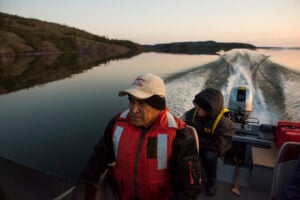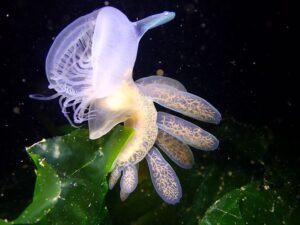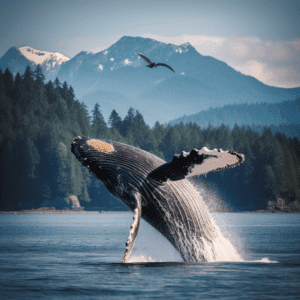BC’s marine ecosystem is home to hundreds of orcas — creatures so intelligent, social, and visually stunning that they have inspired legends among First Nations and fear in early settlers, and now attract legions of fans.
Their fame was evident this spring as people around the world followed the tale of Brave Little Hunter. The two-year-old transient orca was orphaned–and left trapped in a lagoon near Zeballos on Vancouver Island- when her mother, Spong, died after stranding herself hunting. For weeks, local residents and researchers monitored the youngster, tried in vain to trap her in order to move her, and eventually had to feed her seal meat. One night the young whale finally made her way out of the lagoon to the open ocean, where it is hoped she will find her family pod.
What Are Orcas?
There are many misconceptions about Orcinus orca, the marine mammal also known as blackfish, grampus, Qaqawun, Max’inux, Ska-ana, Devil Fish, Wolves of the Sea, and Killer Whales. The last name is the most popular and also apt because orcas are the top ocean predators. However they are not, in fact, whales.
Killer Whales are the largest of the world’s 35 species of oceanic dolphins, and they inhabit almost all the world’s oceans. Males range from 6 to 8 meters long and can weigh more than 6 tonnes, with dorsal fins as high as 2 meters. Females are slightly smaller at 5 to 7 meters long, weighing up to 4 tonnes, with dorsal fins as high as 1.5 meters.
Orcas’ life spans are comparable to that of humans, with an expected age of 70 years or more.
Orcas in BC face interrelated threats to their survival, including food shortages, vessel strikes, underwater noise, and pollution. Because orcas are at the top of the food chain and live for a long time, toxins from pollution like polychlorinated biphenyls (PCBs) concentrate in their bodies, harming their immune and reproductive systems and raising their risk of cancer.
Orcas have inhabited the ocean off BC for hundreds of thousands of years, but some populations are now at great risk from human activities. To survive, the animals need all the help that we can give them and will benefit from Marine Protected Areas (MPAs).
Orcas Are Smart
“Orca brains are enormous, about 5 times the size of humans,” according to the Orca Network, with a complexity “capable of supporting a degree of consciousness that could allow culturally acquired, meaningful communication.”
Each group of orcas vocalizes differently, notes the Orca Network, and “orcas use a communication system we might as well call language.”
“Every member of any given pod or matriline uses the same set of calls, and the majority of calls are shared with the whole community,” it said. “Cultural rules for behaviour are probably communicated by vocal expressions.”
Orcas Are Predators
On the hunt for salmon or seals, at play, and on the move, orcas frequently dive deeper than 100 meters, can swim as fast as 56 kph, and travel as far as 90 to even 175 kilometres in a day.
All orcas are toothsome carnivores, who hunt cooperatively in packs or pods and communicate using clicks, whistles, and calls.
They use echolocation to navigate and find prey, according to Orca Lab. Their sounds pass through the water until they hit an object then boomerang back to the orca, revealing the object’s location, size, and shape.

Orcas Are Social
Orcas are matrilineal, and highly social-especially the subpopulation called Residents, who live lifelong alongside their mothers in pods centred around grandmothers and great-grandmothers.
Female orcas, along with humans and belugas, are among the few mammals that go through menopause. Female orcas that are past child-bearing age are the leaders of their clans.
Orcas have deep attachments to each other. In 2018, the orca known as Tahlequah, or J35, carried her stillborn calf at the surface of the sea for more than two weeks.
Types of Orcas in BC
BC’s four separate populations have evolved with distinct sounds, foods, behaviours, and appearances. Although the habitats of the four types sometimes overlap, they do not mix socially, breed with each other, or share the same dialects.
The two populations of Resident orcas are Southern Resident Killer Whales or SRKW, with a population of about 75, and Northern Resident Killer Whales or NRKW, numbering about 300. Both populations of Resident orcas eat exclusively salmon, with a strong preference for Chinook. Southern Residents are most frequently seen in the Salish Sea off BC and Washington State. Northern Residents range between Washington State and Alaska and are mostly sighted in BC off northern Vancouver Island.
The dorsal fins of Resident orcas are rounded on the tip, and most have open white saddle patches. Residents are the most social and vocal of BC’s orcas.
The third population is composed of Transient orcas, also called Bigg’s killer whales after whale biologist Michael Bigg, who pioneered research on them. Transients are fierce hunters and eat a varied diet of mammals–mainly sea lions and seals, but including other kinds of dolphins and occasionally young whales.
A fourth recently identified and little-understood population is composed of Offshore orcas, which hunt sharks and other fish in deepwater off the coast.
Researchers identify the animals by each one’s unique fin shape, markings, scars, and colour patterns. Individuals are named with letters and numbers. Many–like Brave Little Hunter–also carry human nicknames. Among Residents, the first character of an orca’s name is the letter of their pod, followed by the numbers of that pod in sequence. Transient orca names all begin with T, followed by letters and numbers to indicate their matrilineage.
Orca Clans and Pods
Southern Residents are one single clan, with subgroups known as J Pod, K Pod, and L Pod. They are mostly seen in the Salish Sea and are one of the most studied populations of marine animals on earth, with every individual identified by researchers. Southern Residents can often be seen at play, chasing each other, swimming in the wake of vessels, toying with driftwood, or draping kelp over their bodies.
Northern Resident orcas are divided into three clans, A, G and R, each with several pods ranging from one to 34 individuals. They are mostly sighted north of Vancouver Island, but their range extends from Washington State to Alaska. Northern Residents are known for rubbing their bodies on rocks at smooth, shallow beaches, sometimes for hours at a time.
Transient orcas are larger than Residents, and their dorsal fins are more pointy and shark-like. Their saddle patches are grey. Like Southern Residents they are often spotted in the Salish Sea, as well as on the West Coast of Vancouver Island. Researchers have relatively less data about them.
Offshore orcas, first discovered in 1988, are a bit of a mystery. Researchers suspect they range between the Aleutian Islands and Southern California, and travel and hunt in groups of 100 to 200 individuals. Most sightings of Offshore orcas in BC waters are off Haida Gwaii and the west coast of Vancouver Island.
Offshore orcas appear to be smaller than Residents or Transients, and females have a rounder dorsal fin tip. They are thought to hunt sharks and other fish, according to the Center for Whale Research. Their sound is quite distinct from the voices of Residents and Transients, reports the Orca Network. “Offshores share a distinct repertoire of discrete calls, completely unlike those recorded from other communities.”
Orca Population Status
All orcas in BC are protected under the Fisheries Act Marine Mammal Regulations. It is illegal to harm, harass or kill an orca in Canada, and governments and conservation organizations have many programs in place to aid them. Despite that, all orcas face major threats, with one population, Southern Residents, on the brink of extinction. Threats, according to the federal government, include reduced prey, environmental contaminants, physical disturbance, underwater noise, and vessel strikes.
Because orcas are at the top of the food chain, toxins from pollution concentrate in their bodies over their life span of up to 70 years. Of all marine animals, orcas are especially vulnerable to pollution from polychlorinated biphenyls (PCBs), which persist indefinitely in the environment and are still widely used around the world despite bans in some countries. These toxins harm reproduction and immune systems and cause cancer.
A paper in the journal Science six years ago predicted that because of PCB concentrations in their bodies, more than half the world’s populations of orcas will collapse in the next century.
BC’s 75 Endangered Southern Residents place first in the grim ranking of orca risk. Marine mammal toxicologist Peter Ross told CBC that these killer whales are the marine mammals most contaminated by polychlorinated biphenyls (PCB) on the planet.
Toxins, along with a shortage of Chinook salmon, are suspected as the reason an estimated 50% of Southern Resident’s offspring deaths in the first year of life.
Modern threats are compounded by the fact the Southern Resident clan never recovered from the era in the 1960s and 70s when Canada and the US allowed their capture and sale to aquatic amusement parks around the world.
“The abductors killed at least 13 orcas during the captures; 45 whales ended up in parks across the globe. No Southern Resident killer whale remains alive in captivity,” according to the Center for Whale Research. Just 71 orcas remained. Their population grew to 98 in the mid-1990s and has been in decline since then.
Researchers predict that Southern Residents will soon become extinct unless there is dramatic change. “Preventing extinction is still possible but will require greater sacrifices on regional ocean use, urban development, and land use practices than would have been the case had threats been mitigated even a decade earlier,” said a paper this spring in the science journal Nature. It added, “many threats are expected to worsen in future.” This spring, the federal government announced new measures, including the closure of certain salmon fisheries, new slow-down zones for ships, and banned vessels and fishing in two summer feeding zones.
The population of Northern Residents is in better shape than their Southern cousins and is increasing slowly.
Less is known about Transients, but an estimated population of 350 in BC is growing at about 4% each year, according to Howard Garrett, president of the Orca Network. Transients eat a far more expansive diet than the salmon-eating Residents and benefit from the growth in BC’s seal population with the West Coast of Vancouver Island especially a rich hunting ground, said Garrett.
Orcas In Stories
To Indigenous residents, notes a display at The Royal British Columbia Museum, orcas are ancestors and kin and “are treated as family and respected like elders.”
“Indigenous peoples remember, through oral histories, when orcas walked on land. In stories that have been told since time immemorial, orcas can transform themselves into humans or other animals. They can communicate with people and with all beings to share wisdom, wealth, power, and healing. They can enter our world, and sometimes people enter theirs.”
After Europeans arrived in BC and up to about 50 years ago, orcas were seen as dangerous and threatening and also as competition for resources by commercial fishermen. For decades, orcas were shot on sight. Killer whales were seen “not just as vermin species but potentially dangerous,” University of Victoria historian Jason Colby told CBC.
In 1964 the tragic case of a five-year-old orca named Moby Doll began to change that perception, and is documented in the book “The Killer Whale Who Changed the World.” The young whale survived being harpooned and was hauled, on the line attached to the harpoon in his back, to a Vancouver Aquarium pen. He lived there for three months, and in that time, he inspired scientists who worked with him to change their view of orcas and eventually start the successful campaign against commercial whale hunting and, recently, the keeping of intelligent cetaceans in captivity.
The popular view of orcas has changed so dramatically that there is now a popular children’s book. Granny’s Clan features Granny–AKA J2–who was at least 80 years old when she died in 2016.
Orcas are today prominent in BC art, murals, and greeting cards. They are also represented by the massive sculpture Digital Orca by Douglas Coupland, which stands over Vancouver’s waterfront in view of the passing container ships and oil tankers that threaten orca habitat.
How Do Marine Protected Areas Help Orcas?
To learn more about marine protected areas (MPAs) and how they work, check out this article, or this paper from the Salish Sea Ecosystem Conference.
To learn more about Orcas, check out these organizations:
Watch and listen in real-time to orca webcams and underwater microphones at Orcalab, a science centre on Hanson Island founded by whale researcher Dr. Paul Spon




